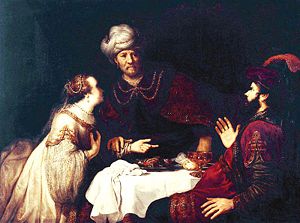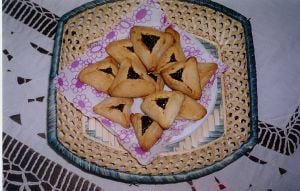Haman (Bible)
Haman (or Haman the Agagite ◊Ē◊ě◊ü ◊Ē◊ź◊í◊í◊ô) is the antagonist in the biblical Book of Esther. According to this story, Haman was a fourth century B.C.E. Persian noble and vizier of the empire under Persian King Ahasuerus, traditionally identified as Artaxerxes II but thought by most modern scholars to be Xerxes I.
In the Book of Esther, Haman conceives an implacable hatred for the Jews after Queen Esther's uncle Mordecai refuses to bow before him as commanded by the king. He then receives the king's authority to exterminate the Jews throughout the empire. Esther, however, cleverly foils his plot, and Haman ends up hanged on the very gallows he had intended for Mordecai.
The story of Esther, Mordecai, and Haman is generally considered fictional by scholars today, as no such figures appear in the annals of Persian history, and the story has more of the qualities of a fairy tale than a historical account.
In Jewish tradition, Haman is the archetypal enemy of the Jews, a type of Hitler before-the-fact. At the Jewish festival of Purim, he is the object of much scorn by participants, especially children, who delight in eating pastries known variously as "Haman's hats" and "Haman's ears."
Biblical data
Haman enters the scene in chapter 3 of the Book of Esther after the beautiful Jewish maiden has become the queen of Persia and her guardian/uncle Mordecai has uncovered a plot to assassinate King Ahasuerus. The king elevates Haman to be his prime minister, and commands his officials to honor Haman by kneeling down before him. Mordecai, however, refuses to kneel. Despite pressure from the king's officers, Mordecai persists in his refusal to obey the king's command.
Learning of Mordecai's behavior, Haman takes offense and determines to take revenge not only on Mordecai himself, but on all of his people. Haman and his wife Zeresh then instigate a plot to kill the entire population of the Jews of Persia. Ahasuerus gives Haman his signet ring and authorizes him to carry out the plan. Haman causes the edict to be sent throughout the Persian empire. All the Jews, including women and children, are to be killed and their properties confiscated.
Mordecai informs Esther of the plot and Haman's role in it, and Esther agrees to help, even at the risk of her life. She devises a scheme to expose Haman and save her people at the same time. Cleverly, she convinces the king to grant her one boon, which she will reveal at a banquet in Haman's honor. Haman, meanwhile, prepares to have Mordecai publicly executed. At his wife's suggestion, he constructs a gallows 75 feet high.
Ahasuerus, however, is mysteriously reminded of Mordecai's loyalty and wishes to reward him. He asks Haman: "What should be done for the man the king delights to honor?" Haman, thinking the king is speaking of Haman himself, replies that he should be given a public parade with great honor. The king immediately commands Haman to have Mordecai honored in the manner suggested, much to the evil minister's chagrin.
The king then hosts the banquet that Esther has planned for Haman. She reveals to Ahasuerus that Haman's plans are to kill her and her people, including even the loyal Mordecai. The king leaves in a rage, and the terrified Haman begs Esther for mercy, only to have the king return and find him in a compromising position that the king interprets as an attempt to molest the queen.
The wicked Haman meets his just fate on the very gallows he had prepared for Mordecai. The loyal Mordecai then becomes prime minister in Haman's place, and the king issues a new edict authorizing the Jews to take revenge on their enemies. In a final act of fate, the dead bodies of Haman's ten sons are also hanged after they die in battle against the Jews, ending his evil lineage forever.
Name and lineage
Several etymologies have been proposed for the name Haman. It has been equated with the Persian name Omanes recorded by Greek historians, derived from the Persian Vohuman. Alternatively it has been associated with the Persian word Hamayun meaning "illustrious" (naming dictionaries typically list this name as meaning "magnificent"), or with the sacred drink Haoma.
In the Book of Esther, Haman is described as the son of Hammedatha the Agagite. Agag was the Amalekite king who was executed by Samuel the prophet in the time of King Saul, and the Amelekites are described in biblical and rabbinical tradition as Israel's implacable enemy.
Haman's lineage is given in the Targum Sheni as follows: "Haman the son of Hammedatha the Agagite, son of Srach, son of Buza, son of Iphlotas, son of Dyosef, son of Dyosim, son of Prome, son of Ma'dei, son of Bla'akan, son of Intimrom, son of Harirom, son of Sh'gar, son of Nigar, son of Farmashta, son of Vayezatha, son of Agag, son of Sumki, son of Amalek, son of the concubine of Eliphaz, firstborn son of Esau."
In rabbinical literature

In Rabbinical tradition, Haman is considered an archetype of evil and persecutor of the Jews. Having attempted to exterminate the Jews of Persia, and rendering himself thereby their worst enemy, Haman naturally became the center of many Talmudic legends.
Being at one time in extreme want, he said to have sold himself previously as a slave to Mordecai (Meg. 15a). He was also a barber for the space of 22 years (ib. 16a). The reason for Mordecai's refusal to humble himself before Haman was that Haman had an idolatrous image embroidered on his garments, so that those who bowed to him at command of the king also bowed also to the image (Esth. R. vii.).
Haman was also an astrologer, and when he was about to fix the time for the massacre of the Jews he first cast lots to ascertain which was the most auspicious day of the week for that purpose. Each day, however, proved to be under some influence favorable to the Jews. He then sought to fix the month, but found that the same was true of each month. The month of Nisan was favorable to the Jews because of the Passover sacrifice; Iyyar, because of the small Passover, etc. But when he arrived at the month of Adar he found that its zodiacal sign was Pisces, and he said, "Now I shall be able to swallow them as fish which swallow one another" (Esth. R. vii.; Targ. Sheni iii).
Haman had 365 counselors, but the advice of none was so clever as that of his wife, Zeresh. When she induced Haman to build the gallows for Mordecai, she assured him that this was the only way in which he would be able to prevail over his enemy, for hitherto the righteous had always been rescued from every other kind of death.
When God foresaw that Haman himself would be hanged on the gallows he asked which tree would volunteer to serve as the instrument of death. Each tree, declaring that it was used for some holy purpose, objected to being soiled by the unclean body of Haman. Only the thorn tree could find no excuse, and therefore offered itself for a gallows (Esth. R. ix.; Midr. Abba Gorion vii).
Haman is also mentioned by Josephus in his Antiquities of the Jews. His account of the story is drawn from the Septuagint translation of the Book of Esther and from other Greek and Jewish sources, some are no longer extant.
Legacy
The Jewish holiday of Purim commemorates the story of the deliverance of the Jews and the defeat of Haman. On that day, the Book of Esther is read publicly and much noise and tumult is raised at every mention of Haman's name. A special noisemaker called a gragger is used to express disdain for Haman. Pastry known as hamentashen (hats or ears of Haman) are traditionally eaten on this day.
Purim is an occasion on which much joyous license is permitted within the walls of the synagogue itself. For example, during the public service in many congregations, when the reader of the Book of Esther mentions Haman (54 occurrences), there is boisterous hissing, stamping, and rattling. Outside the synagogue, the pranks are carried to even to a greater extreme. Some of them date from the Talmudic period. As early as the fifth century, it was a custom to burn or hang Haman in effigy on Purim, similar to the British custom for Guy Fawkes Day. This tradition persisted into the twentieth century but is no longer generally practiced.
ReferencesISBN links support NWE through referral fees
- Greenspoon, Leonard J., and Sidnie White Crawford. The Book of Esther in Modern Research. London: T & T Clark International, 2003. ISBN 9780826466631.
- Glickman, Elaine Rose. Haman and the Jews: A Portrait from Rabbinic Literature. Northvale, NJ: Jason Aronson, 1999. ISBN 9780765760968.
- Hoschander, Jacob. The Book of Esther in the Light of History. Philadelphia: Dropsie College for Hebrew and Cognate Learning, 1923. OCLC 613337.
- Laniak, Timothy S. Shame and Honor in the Book of Esther. Atlanta, GA: Scholars Press, 1998. ISBN 9780788505058.
- Moore, Carey A. Studies in the Book of Esther. The Library of Biblical studies. New York: Ktav Pub. House, 1981. ISBN 9780870687181.
- This article incorporates text from the 1901‚Äď1906 Jewish Encyclopedia, a publication now in the public domain.
Credits
New World Encyclopedia writers and editors rewrote and completed the Wikipedia article in accordance with New World Encyclopedia standards. This article abides by terms of the Creative Commons CC-by-sa 3.0 License (CC-by-sa), which may be used and disseminated with proper attribution. Credit is due under the terms of this license that can reference both the New World Encyclopedia contributors and the selfless volunteer contributors of the Wikimedia Foundation. To cite this article click here for a list of acceptable citing formats.The history of earlier contributions by wikipedians is accessible to researchers here:
The history of this article since it was imported to New World Encyclopedia:
Note: Some restrictions may apply to use of individual images which are separately licensed.


